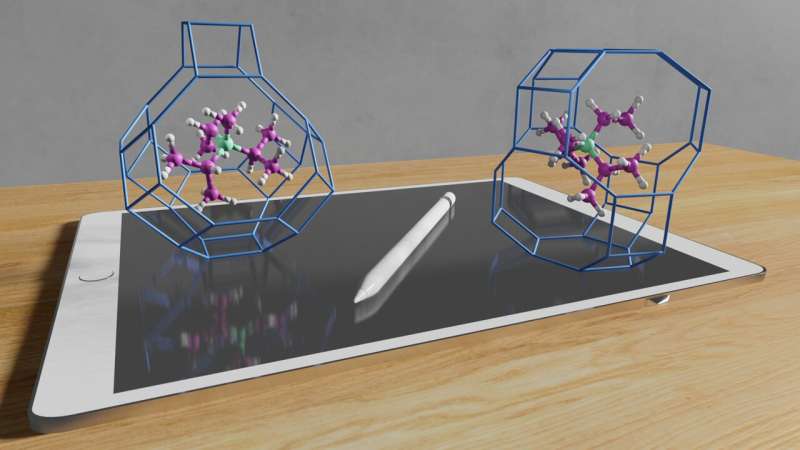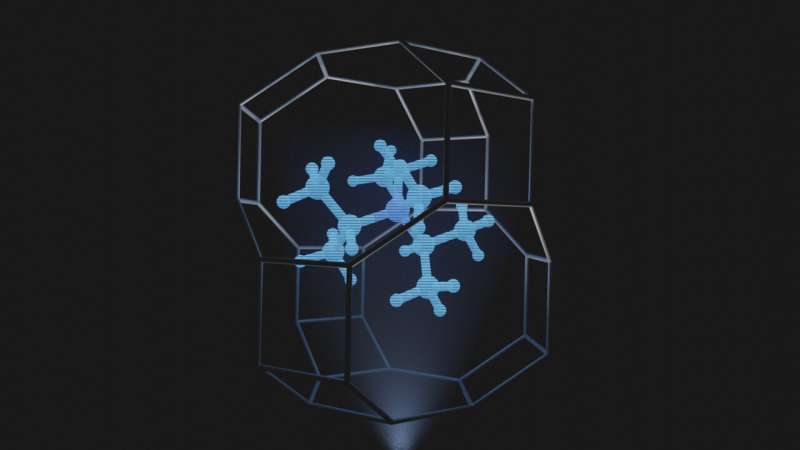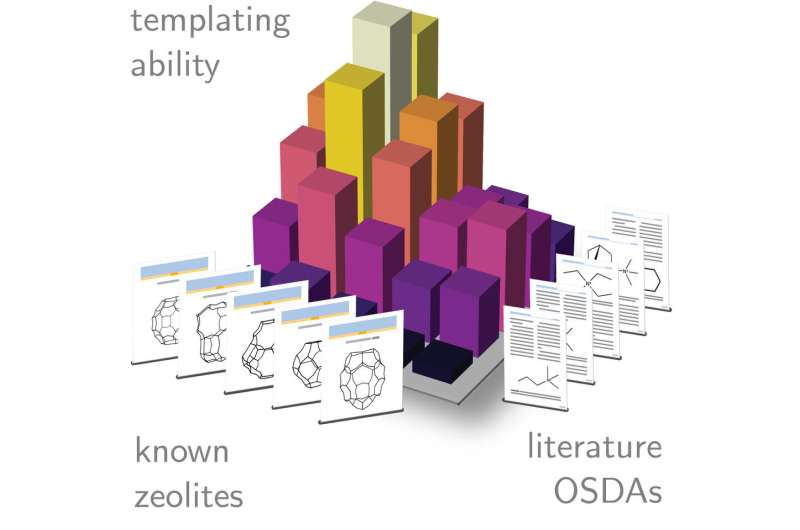September 24, 2021 feature
A strategy to control phase selectivity in templated zeolite synthesis

Zeolites, groups of minerals comprising of hydrated aluminosilicates, are known to be highly promising materials for a number of applications. For instance, they can be used as catalysts, cation exchangers and molecular sieves.
While many past studies have examined the potential of these materials, so far managing phase competition during zeolite synthesis has proved to be challenging and labor-intensive. The term zeolite synthesis refers to the processes through which zeolites can be created or synthesized in the lab.
Researchers at Massachusetts Institute of Technology (MIT), in collaboration with researchers at Polytechnic University of Valencia and Stockholm University, have recently proposed a new strategy to control phase selectivity during templated zeolite synthesis processes. This strategy, presented in a paper published in Science, is based on the combined use of atomistic simulations, literature mining, human-computer interactions, synthesis and material characterization techniques.
"Our research in the Learning Matter Lab at MIT focuses on needle-in-a-haystack problems in materials science," Rafael Gomez-Bombarelli, one of the researchers who carried out the study, told Phys.org. "Designing a molecule that selectively templates a given zeolite has been a difficult combinatorial problem for decades, with lots of trial and error in the lab. Although atomistic simulations have historically helped, traditional approaches were missing the role of selectivity because they focused on a single zeolite at a time."

Gomez-Bombarelli and his colleagues used high-throughput simulations based on molecular mechanics to quantify the affinity of different molecular templates to both the zeolite they were trying to create and those that were unsuitable for a given application. The team drew information from over 586,000 zeolite-molecule simulations that were aligned with existing literature in materials design.
"Using these simulations, we found templates that are most selective even if they are not the strongest binders," Daniel Schwalbe-Koda, another researcher involved in the study, told Phys.org. "Thanks to fast algorithms that we fine-tuned over the previous year and that we benchmarked against decades of literature data, our simulations were orders of magnitude faster than traditional approaches and allowed us to reach a large number of combinations very efficiently."
The results of the simulations led to the identification of several possible designs for zeolites that could potentially be realized in the future. While there is no certainty that all the designs they identified would be ideal, the work by Gomez-Bombarelli, Schwalbe-Koda and their colleagues could help to narrow down the search for promising zeolite designs and speed up zeolite synthesis processes.
"Theory has typically supported experiments in zeolite science, but rarely led the way," Manuel Moliner, one of the researchers who conducted the study, told Phys.org. "With these new insights, our chances of success when we set out to make novel materials in the lab are much higher and there are lots of untapped potential in molecules that hadn't received attention but can unlock novel, efficient and cost-effective catalysts."

This recent study confirms that highly performing computational tools and algorithms could play a key role in the identification of new promising materials. Nonetheless, the researchers strongly believe that the intuition of expert humans is still necessary when analyzing computer simulations or an algorithm's predictions.
"At the end of the day, humans are the final users of the data, so we should try to make it as useful as possible for practical applications," Schwalbe-Koda said. "One of my favorite insights of our study is that molecular shape is a great predictor of selectivity. We were able to create a new material that is halfway between two known ones, by using a template whose shape is halfway between the molecules traditionally used."
The new computational strategy for controlling zeolite synthesis and structure composition presented by Gómez-Bombarelli, Schwalbe-Koda, Moliner and their colleagues could soon aid the discovery of new promising zeolite templates. This could have important implications for several research fields, including the energy field and efforts to tackle climate change. The researchers have thus decided to make their data publically available through an online interactive website.
"There are many exciting avenues for future research," Moliner said. "Two that are of theoretical and practical interest come to mind. One is customizing the composition and geometry of catalytic pocket in the zeolite and move towards "inorganic enzymes." Another is realizing completely new zeolites that for now remain purely hypothetical. By making our simulation data available to the community we expect others will also be inspired to pursue new creative directions."
More information: Daniel Schwalbe-Koda et al, A priori control of zeolite phase competition and intergrowth with high-throughput simulations, Science (2021). DOI: 10.1126/science.abh3350
Journal information: Science
© 2021 Science X Network





















